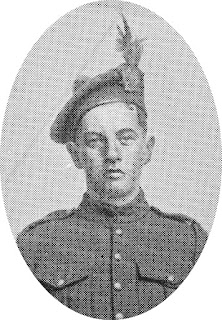 |
| May 30, 1916: Marching to the docks. |
Throughout the months of March and April, military recruiters visited towns and villages of Nova Scotia in search of volunteers for the three new battalions. The 193rd’s officials canvassed northeastern Nova Scotia—Cumberland, Colchester, Pictou, Antigonish, Guysborough and Hants Counties—visiting smaller settlements such as Sherbrooke, Canso and Guysborough town for the first time since the war began in early August 1914.
The entire Brigade was recruited to full strength within three weeks, the new units establishing detachments and immediately commencing training in the province’s larger towns and villages. During the last week of May 1916, the Brigade commenced its mobilization at Camp Aldershot, marking the beginning of a summer-long schedule of military drill and route marches. On May 30, the Guysborough detachment marched along the town’s main street to the pier, boarded the coastal steamer LaTour and travelled to Mulgrave for the train ride to Aldershot.
 |
| May 30, 1916: 193rd recruits departing Guysborough. |
On August 25, Aldershot opened its doors to the public for two days. Over 8,000 Nova Scotians flocked to the camp, HRH the Duke of Connaught, Governor-General of Canada, reviewing the Brigade’s troops in a March Past held the following day. Personnel commenced preparations for their overseas departure the following month, Lt.-Col. Borden departing for England on September 9, eventually making his way to France to observe conditions at the front. In his absence, Lt.-Col. John Stanfield, the 193rd’s CO, assumed command of the Brigade. On September 26, Lady Borden, wife of Sir Robert Borden, Canadian Prime Minister and the Brigade’s Honorary Colonel, presented the King’s and Battalion Colours to each unit.
At month’s end, the Brigade staged a “grand gymkhana,” consisting of “interesting and amusing sporting events” traditionally referred to as “Scotch Games,” according to Lieutenant-Colonel Joseph Hayes, the 85th’s Medical Officer and post-war chronicler. Having fulfilled its ceremonial, public relations and recreational duties, the Brigade commenced final preparations for its overseas departure. Amongst the various tasks was the assembly and publication of A Short History & Photographic Record of the Nova Scotia Overseas Highland Brigade, C. E. F., containing a brief description of each unit’s origin and portraits of its initial personnel.
 | ||
| Four Guysborough County 193rd soldiers at Camp Aldershot. |
Above: Tommy Suttis, killed at Passchendaele, Belgium with 85th Bn., Oct. 30, 1917;
Matthew "Mack"Manson, wounded at Scarpe, France with 85th Bn., Sept. 2, 1918;
Frank Burton McLane, served with 2nd Cdn. Tunnelling Coy. in Belgium & France;
Blair Archibald, discharged as medically unfit on October 9, 1916.
Unfortunately, military authorities disbanded the Brigade before year’s end, due largely to the significant numbers of Canadian Corps casualties incurred at the Somme, France during the months of September to November 1916. Two of the Brigade’s four units—the 193rd and 219th—were dissolved, their soldiers reassigned to existing units in the field. Before war’s end, however, virtually all of the 193rd’s initial recruits saw action at the front. Some did not return home, while others were wounded in combat or became ill during service and were “invalided” to Canada. Even those who came through the fray without physical injury carried the psychological effects of the 20th century’s first modern war for the remainder of their days.



